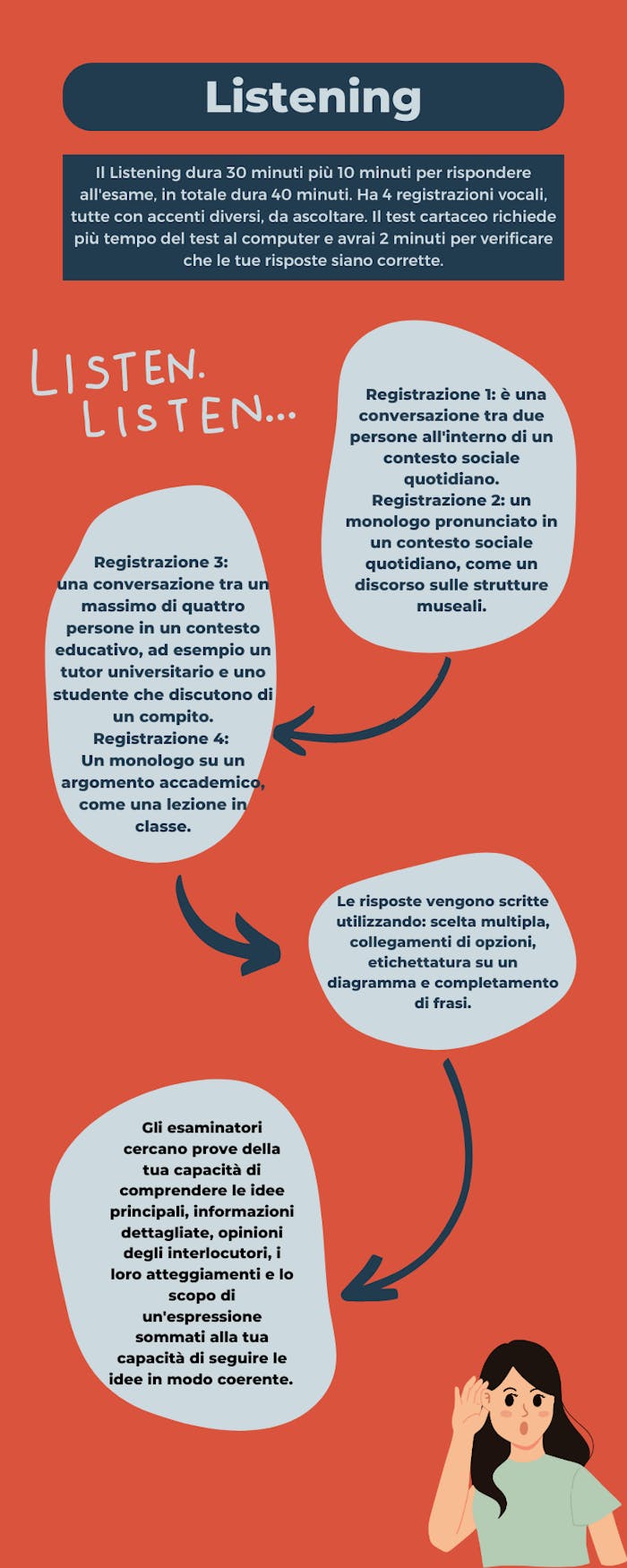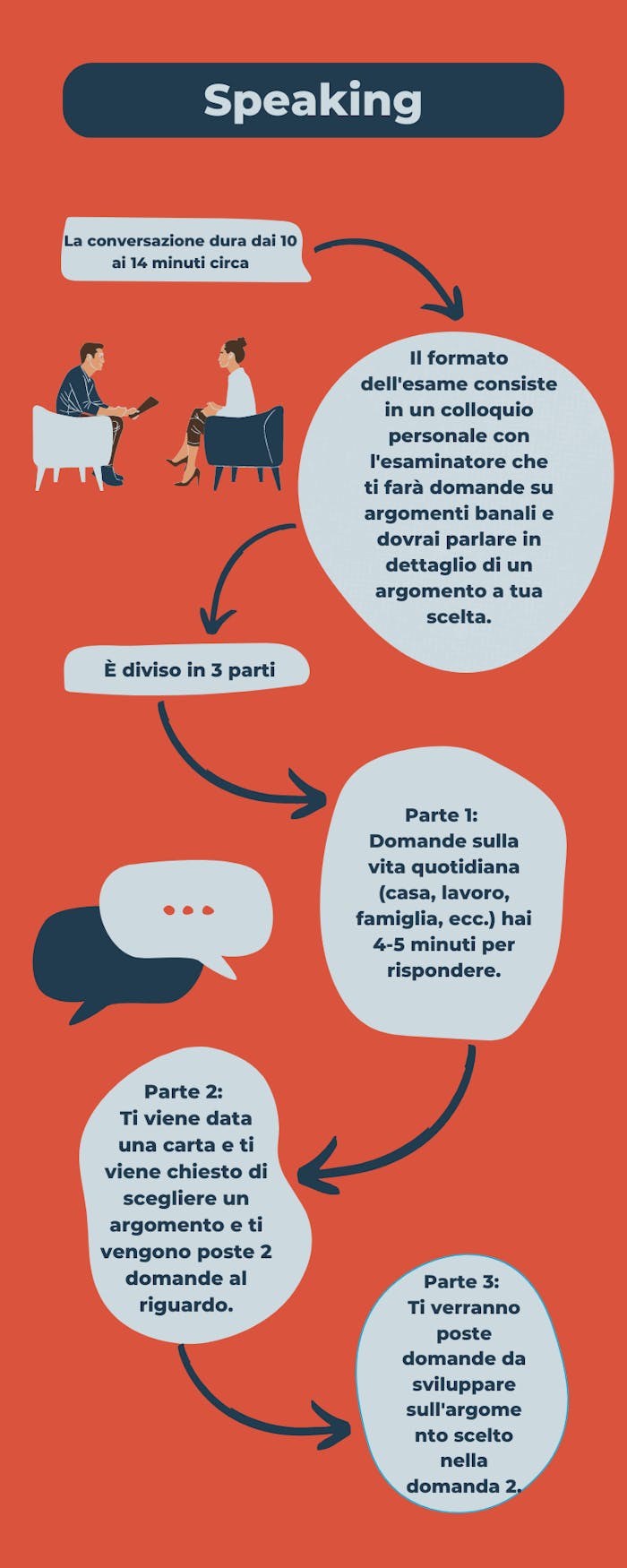Esame IELTS: Simulazione, preparazione, formato e punteggi del esame di inglese
L'esame IELTS: ha 3 versioni, Academic, General Training, IELTS UKVI e Life Skills. Hanno tutti una divisione in 4 parti simile al TOEFL: Listening, Reading, Writing y Speaking. Gli esami si svolgono in centri autorizzati e specializzati.
In ogni caso, pur avendo lo stesso formato, questi 3 modelli d'esame hanno uno scopo diverso e per il quale vengono dati. Academic è per chiunque voglia studiare in paesi di lingua inglese, General è per chiunque voglia trasferirsi in paesi di lingua inglese,UKVI è emigrare nel Regno Unito e Life Skills verifica l'inglese di base.
Da Speakingathome possiamo aiutarti in modo che tu possa dare il massimo quando stai affrontando l'esame.

Formato IELTS
La valutazione, come detto prima, è data in 4 parti:

IL Reading ha 60 minuti, devono essere letti 3 testi lunghi (con diagrammi, grafici e illustrazioni), i testi possono variare da formati descrittivi e fattuali, discorsivi e analitici. Dispone di 40 domande create per testare la gamma di capacità di comprensione della lettura dell'esaminato, ergo la comprensione delle idee principali, i dettagli, l'argomentazione logica e il riconoscimento delle opinioni degli autori del testo, atteggiamenti e finalità. I testi sono tratti da articoli di giornali, riviste, ecc. e scelti perché non rivolti a un pubblico specializzato.

IL Writing, della durata di 60 minuti, è suddivisa in 2 compiti: nel primo devi scrivere un documento di almeno 150 parole dove devi riassumere, spiegare o descrivere il testo fornito. Nel secondo, dovrai scrivere un saggio in cui la tua risposta è argomentata contro un punto di vista, un argomento o una situazione contrastanti e ha un minimo di 250 parole.
Punteggi IELTS
I punteggi degli esami sono gli stessi per tutti i tipi di IELTS (Academic, General Training e IELTS UKVS), ma in Life Skills è superato o fallito. La modalità di valutazione degli esami va da voti (o fasce) da 0 a 9.
I voti, a seconda dei risultati, possono essere suddivisi in voti pieni (1,3,5) o mezzi voti (2,5, 4,5 ecc.). I gradi di qualificazione sono assegnati come segue:
- 9: Utente esperto
- 8: Ottimo utente
- 7: Buon utente
- 6: Utente competente
- 5: Utente modesto
- 4: Utente limitato
- 3: Utente molto limitato
- 2: Utente intermittente
- 1: Nessun utente
- 0: Non ha sostenuto l'esame
Questi risultati rispetto al Quadro Comune Europeo di Riferimento (CEFR) sarebbero i seguenti: 4 equivale al livello A2 confinante con B1, da 4.5 a 5 equivale a livello B1, da 5.5 a 6.5 equivale a B2, da 7 a 8 equivale a C1 e infine da 8 a 9 equivale a un livello C2 in inglese.
Preparazione IELTS
Sostenere un esame non è mai semplice, si ha sempre la sensazione di non essere mai sufficientemente preparati, ma quei sentimenti di inadeguatezza possono sempre essere risolti con uno sforzo netto e costante.
Per prepararsi all'esame IELTS, la maggior parte delle accademie inglesi consiglia di iniziare a studiare circa 6 mesi prima della data dell'esame. Poiché ogni sezione dell'esame richiede un diverso modo di prepararsi.
Reading: Ciò che è necessario per essere in grado di prepararsi alla lettura è esercitarsi nella comprensione della lettura di testi, regole ortografiche, regole verbali, ecc. Si consiglia di leggere testi in inglese, come siti di notizie (bbc.com, cnn.com ecc.) se si desidera avere una conoscenza generale dell'uso della parola, ma è anche possibile leggere qualsiasi pagina come sempre che sia in inglese.
Writing: Per migliorare le tue capacità di scrittura, ti consigliamo di selezionare un argomento a caso e provare a scrivere testi lunghi per non più di 20 minuti, quindi provare a cronometrare il tuo tempo in modo che sia sempre meno.
Listening: Per la pratica dell'ascolto si consiglia di ascoltare delle lezioni in inglese per allenare l'orecchio ma anche l'ascolto della musica può aiutare.Si sconsiglia di ascoltare canzoni che hanno un accento molto chiuso o un forte uso della parola colloquiale del musicista ma piuttosto canzoni più regolari come quelle di Frank Sinatra o Elvis Presley.
Speaking: Se vuoi parlare inglese in modo fluente, è consigliabile comunicare con madrelingua inglese. Un'opzione è quella di andare nei bar frequentati da immigrati anglofoni, ma è meglio se decidi di fare un corso online per esercitarti.
Simulazione dell'esame IELTS
Questa è una simulazione, l'esperienza di vita reale può variare.
Listening
PART 1
Questions 1 – 8 Complete the form below. Write NO MORE THAN THREE WORDS AND/OR A NUMBER for each answer.
PACKHAM’S SHIPPING AGENCY – customer quotation form
Name: Jacob 1 …………
Address to be collected from: 2 ………… College, Downlands Rd
Town: Bristol
Postcode: 3 …………
Size of container: Length: 1.5m Width: 4 ………… Height: 5 …………
Contents: Clothes 6 ………… 7 …………
Total estimated value: 8 £…………
Reading
This is an extract from an Academic Reading passage on the development of rockets. The text preceding this extract explored the slow development of the rocket and explained the principle of propulsion.
The invention of rockets is linked inextricably with the invention of 'black powder'. Most historians of technology credit the Chinese with its discovery. They base their belief on studies of Chinese writings or on the notebooks of early Europeans who
settled in or made long visits to China to study its history and civilisation. It is probable that, some time in the tenth century, black powder was first compounded from its basic ingredients of saltpetre, charcoal and sulphur. But this does not mean that it was immediately used to propel rockets. By the thirteenth century, powder propelled fire arrows had become rather common. The Chinese relied on this type of technological development to produce incendiary projectiles of many sorts, explosive grenades and possibly cannons to repel their enemies. One such weapon was the 'basket of fire' or, as directly translated from Chinese, the 'arrows like flying leopards'.
The 0.7 metre-long arrows, each with a long tube of gunpowder attached near the point of each arrow, could be fired from a long, octagonal-shaped basket at the same time and had a range of 400 paces. Another weapon was the 'arrow as a flying sabre', which could be fired from crossbows. The rocket, placed in a similar position to other rocket-propelled arrows, was designed to increase the range. A small iron weight was attached to the 1.5m bamboo shaft, just below the feathers, to increase the arrow's stability by moving the centre of gravity to a position below the rocket. At a similar time, the Arabs had developed the 'egg which moves and burns'. This 'egg' was apparently full of gunpowder and stabilised by a 1.5m tail. It was fired using two rockets attached to either side of this tail.
It was not until the eighteenth century that Europe became seriously interested in the possibilities of using the rocket itself as a weapon of war and not just to propel other weapons. Prior to this, rockets were used only in pyrotechnic displays. The incentive for the more aggressive use of rockets came not from within the European continent but from far-away India, whose leaders had built up a corps of rocketeers and used rockets successfully against the British in the late eighteenth century.
The Indian rockets used against the British were described by a British Captain serving in India as ‘an iron envelope about 200 millimetres long and 40 millimetres in diameter with sharp points at the top and a 3m-long bamboo guiding stick’. In the early nineteenth century the British began to experiment with incendiary barrage rockets. The British rocket differed from the Indian version in that it was completely encased in a stout, iron cylinder, terminating in a conical head, measuring one metre in diameter and having a stick almost five metres long and constructed in such a way that it could be
firmly attached to the body of the rocket. The Americans developed a rocket, complete with its own launcher, to use against the Mexicans in the mid-nineteenth century. A long cylindrical tube was propped up by two sticks and fastened to the top
of the launcher, thereby allowing the rockets to be inserted and lit from the other end. However, the results were sometimes not that impressive as the behaviour of the rockets in flight was less than predictable
Questions 1 – 3
Look at the following items (Questions 7-10) and the list of groups below. Match each item with the group which first invented or used them.
Write the correct letter A-E in boxes 7-10 on your answer sheet. NB You may use any letter more than once.
7 black powder
8 rocket-propelled arrows for fighting
9 rockets as war weapons
10 the rocket launcher
First invented or used by
A the Chinese
B the Indians
C the British
D the Arabs
E the Americans
Writing
TASK 1
You should spend about 20 minutes on this task.
The chart below shows the number of men and women in further education in Britain in three periods and whether they were studying full-time or part-time. Summarise the information by selecting and reporting the main features, and make comparisons where relevant
Write at least 150 words.
TASK 2
You should spend about 40 minutes on this task.
Write about the following topic:
Children who are brought up in families that do not have large amounts of money are better prepared to deal with the problems of adult life than children brought up by wealthy parents. To what extent do you agree or disagree with this opinion?
Give reasons for your answer and include any relevant examples from your own knowledge or experience. Write at least 250 words
Speaking
Part 1 Introduction and interview
[This part of the test begins with the examiner introducing himself or herself and
checking the candidate’s identification. It then continues as an interview.]
Let’s talk about your home town or village.
• What kind of place is it?
• What’s the most interesting part of your town/village?
• What kind of jobs do the people in your town/village do?
• Would you say it’s a good place to live? (Why?)
Let’s move on to talk about accommodation.
• Tell me about the kind of accommodation you live in?
• How long have you lived there?
• What do you like about living there?
• What sort of accommodation would you most like to live in?
Part 2 – Individual long turn
Candidate Task Card
Describe something you own which is very important to you.
You should say:
where you got it from
how long you have had it
what you use it for
and explain why it is important to you.
You will have to talk about the topic for 1 to 2 minutes.
You have one minute to think about what you're going to say.
You can make some notes to help you if you wish.
Rounding off questions
• Is it valuable in terms of money?
• Would it be easy to replace?
Part 3 – Two-way discussion
Let’s consider first of all how people’s values have changed.
• What kind of things give status to people in your country?
• Have things changed since your parents’ time?
Finally, let’s talk about the role of advertising.
• Do you think advertising influences what people buy?

